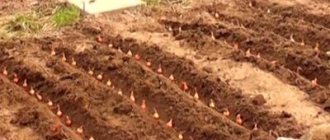Peonies are beautiful spring flowers. They are magnificent in their variety of colors and shapes. In order for them to grow wonderfully lush and fill the garden with fragrance, you should work hard when planting them.
You will learn from this article about when it is optimal to plant peonies in the fall in different regions of the country, about the peculiarities of planting them in open ground, as well as about care after planting and typical mistakes of novice summer residents.
When to plant peonies in the fall - in what month
It is rightfully believed that autumn is the most optimal period for planting peonies in open ground.
Although some gardeners plant in the spring, there are several reasons why most often the planting of seedlings is postponed until the fall. Firstly, spring is a time of increased growth, which leads to depletion of the root system. Secondly, when planting in March-April, you will hardly have to wait for flowering this year.
Note! Read about planting peonies in spring in this material.
As for the specific timing for planting peonies in the fall, the best time to plant a young seedling in the middle zone (Moscow region) is the end of August-September.
Advice! You need to choose a moment when the summer heat has already subsided, and in the evenings the temperature begins to differ noticeably from the daytime. Moreover, just in time for the beginning of September, heavy rains come to our gardens, which only have a positive effect on the rooting of young seedlings.
An important point is the planting period - it is required that 30-40 days remain before the onset of winter cold. During this period, the shrub grows additional roots and completely takes root in a new place.
If you delay planting a peony in the fall, the bush will not have time to take root in time. This will provoke poor wintering conditions, which will lead to weakened immunity and frequent plant diseases.
Thus, peonies should be planted in open ground in the fall about a month before the onset of frost. Otherwise, normal growth of the bush and its flowering may be absent.
Note! Sometimes it happens that circumstances force you to plant a peony later than the recommended dates (for example, in October-November).
What to do in this case?
- It is necessary to plant the plant in a pot and first place it in a greenhouse. This is done so that suction hairs are formed on the roots. If they are not there, then the rhizome will not receive water, that is, it will become dehydrated, and this is very dangerous and has a bad effect on wintering.
- After some stay in the greenhouse (2 weeks is enough or if the temperature drops below 0), it is recommended to dig the peony pot directly into the ground (in winter, the soil freezes in the greenhouse in exactly the same way as outside it).
- Next fall you will be able to transplant the flower from the pot into open ground.
Peony planting dates in different regions
Climate features have a direct impact on planting dates in different regions.
Thus, in Siberia and the Urals, peonies are planted in the fall in August and early September. Late planting will not produce results for optimal growth next year. Most likely, the bush will simply die when cold weather sets in.
In the middle zone (Moscow region), autumn planting of peonies is carried out from the end of August until the last days of September (although very often it continues into the month of October) . This time is enough to take root and prepare for the winter cold. In addition, this climatic zone usually enjoys heavy rains in September, so watering is practically not required.
Naturally, the latest time for planting peonies in the fall is in the southern regions. Here planting is carried out from October to November. In addition, the mild climate and warm winters make it possible not to cover young plants.
How to plant peonies in open ground in the fall - features and step-by-step instructions
Before starting planting work in the garden, you should accurately determine the optimal place for planting young peony seedlings, choose a seedling of excellent quality and properly prepare it for autumn planting, and also know at what depth to plant and how to fertilize the soil before planting.
What should a seedling be like?
Peony seedlings are purchased in specialized garden stores or on online sites. If you want your seedling to quickly begin to grow and not get sick, then it is recommended to carefully approach the choice of planting material.
A good option would be a 1-2 year old seedling with several growth points, but it is even better to purchase 3-4 year old seedlings with 3-4 buds. As for their size, it is optimal that the rhizomes are about 20-25 cm in length (height) . As a last resort, you can take a smaller option - from 15-20 cm, but you need to check the number of growth points (buds) on it, of which there should be at least 2-3 pieces. The roots should be fresh and light in color.
Advice! It is recommended to purchase planting material from adult bushes that are divided. It is these seedlings that take root well and bloom profusely.
You should not buy dried seedlings - it is difficult or even impossible to bring them back to life. Black dried growth points are also not viable The seller’s assurances that the sleeping buds will wake up should not be trusted; this is unlikely to happen. Moreover, you should not buy very small roots without buds.
How to prepare a seedling for planting
A purchased peony seedling must first be prepared and processed before being planted for permanent residence in the garden. To do this, it must undergo a number of preventive measures that will allow the plant to increase its immunity.
Here's what you need to do to prepare and process a peony seedling before autumn planting:
- First of all, carefully examine the roots. To do this, first rinse them well in warm water and dry.
- All traces of rot must be removed with a sharp knife. You also need to remove all small and rotten roots.
- Disinfect by immersing for 20-30 minutes in a solution of potassium permanganate or the drug “Maxim” (special disinfectant).
- It is also recommended to keep the rhizomes in a solution of one of the root formers (root stimulants), for example, in “Zircon”, or dust them with “Kornevin”.
- Then fresh sections of rhizomes should be sprinkled with crushed activated carbon or wood ash.
- Then dry in a shaded place for 24 hours. This is necessary to form a cork layer, which helps protect the shrub from disease.
After the preparatory measures, the peony seedling is planted in the selected place, which must be prepared in advance.
Landing location
In order for the peony to take root safely, grow actively and delight you with lush flowering, you must choose a suitable place for its autumn planting. Such an ideal place in the garden should meet and satisfy the following requirements:
- Sufficient amount of sunlight
, although the shrub also blooms well in light partial shade. Optimally if
during the day in the afternoon (that is, in the heat of the day), peonies will be in the shade, and the rest of the time - in the sun (preferably in the morning - before lunch). If you plant the shrub in a place that is too shady, the peony’s stems will begin to stretch out and the inflorescences will become smaller, or flowering will stop altogether.
Advice! You should not plant peonies between or under spreading trees or overgrown shrubs, which will constantly shade the flower bushes. Although, if you plant on the south side, then this is quite acceptable, but not on the north, east or west side.
- The site is protected from drafts and strong winds , and there is also good air circulation , i.e. it doesn't stagnate.
- Under no circumstances should peonies be planted in damp places . The plant is very prone to getting wet. Accordingly, it is not recommended to place seedlings in an area with very low groundwater (at least 70-80 cm from the surface). This arrangement negatively affects the peony roots - they begin to rot, which leads to disease and death. Alternatively, you can plant them in raised beds.
- It is beautiful to plant peonies along with lilies , phlox , delphiniums , clematis , and irises .
What kind of soil is needed
Peony will grow best on loam that is neutral in acidity (soil with a high clay content and a significant amount of sand). Such soil is capable of both receiving and retaining nutrient moisture.
Important! If the soil is acidic, then you need to add calcareous materials (deoxidizers): dolomite flour , lime, wood ash (this is also an excellent fertilizer).
Preparing the planting pit and nutrient soil
It is recommended to prepare a planting hole for the autumn planting of peonies 1-2 months before the proposed work. This is necessary so that the soil has time to settle and be thoroughly compacted.
Advice! When digging a hole, set aside the top fertile soil separately; it will still be needed.
The optimal dimensions of the planting hole for planting a peony are 70 centimeters deep and 60-70 cm wide. The need to dig such a large hole is due to the fact that the root system of the plant grows quite powerfully and can penetrate to a depth of 50 cm, which means it makes sense to fill it with fertile soil.
If you plan to plant several peonies, then the distance between the bushes should be at least 1 meter, and preferably 1.5 meters.
Next, you need to correctly fill the planting hole:
- As the first layer (10-15 cm), it is necessary to lay drainage so that there is no stagnation of moisture. Broken brick, pebbles or expanded clay are perfect for these purposes.
Important! Drainage is simply necessary on soils with high groundwater, because... Peonies are very afraid of getting wet.
- Next, pour a little sand (5 cm) on top.
- Now we need a layer of fertile soil . To do this, you need to take a bucket of good humus or compost (8-9 kg), or rotted manure (horse manure is best), 60-80 grams of superphosphate and 40-60 grams of potassium sulfate) or 1-2 cups (100-200 grams) of wood ash , as well as the top layer of fertile soil remaining after digging the hole, and mix everything thoroughly.
By the way! Additionally, for greater soil fertility (or instead of superphosphate ), you can add bone meal . The peony really loves to eat this kind of thing.
Direct landing
Step-by-step instructions for planting peonies in open ground in the fall:
- Purchase quality peony seedlings.
- Choose the optimal place in the garden, prepare a planting hole and fill it correctly with fertile soil, not forgetting to add a drainage layer.
- Prepare seedlings for planting.
- Place the seedling in the hole. It is very important to control the depth of growth points (buds). They should be no deeper than 4-5 cm (if the soil is light, then 5-6 cm is possible; if it is heavy, then 3-4 cm). If you bury the seedling too deeply, the plant may stagnate or simply not bloom. On the contrary, if the seedling is too close to the surface of the earth, its buds may freeze in winter and it will bloom very weakly.
- Cover with fertile soil.
- Next, you need to carefully squeeze the earth with your hands, compacting it. This will provoke subsidence of the soil and the removal of possible voids between the roots and the ground.
- Water generously.
- If necessary, add more soil (if it subsides).
- If desired, mulch with compost or peat.
Note! If you are planting 1-2 year old peony seedlings, then in the first 1-2 years it is recommended not to let them bloom and pick off the buds yourself so that the plant grows small suction roots. Peonies begin to bloom profusely only at 3-4 years old, so many people plant 3-4 year old seedlings.
Video: planting peonies in autumn
Important! It is worth noting that planting a tree peony is not from planting
But it is worth knowing that the herbaceous peony always blooms on the shoots of the current year, and the tree peony always blooms on the shoots of the previous year.
Features of autumn transplantation
Peonies do not really like frequent migrations to new places. Especially tree-like species are characterized by a long stay in one habitable area (up to 10-15 years). The only natural reason for replanting it is excessive growth of the bush, when it literally requires forced division and replanting.
Preparation of planting material
Planting work in the fall is carried out after dividing the overgrown peony. The following criterion will help you understand whether the bush is ready for propagation and transfer to a new location: before dividing, the plant must bloom for at least 3 years. There should be more than 7 stems on it. In this case, they should be placed at intervals of 7 cm from one another.
Peony division in the fall is carried out according to the following system:
- In the last days of August or early September, all faded shoots and foliage of the perennial are cut off. In their place there should be stumps 15 cm long.
- The bush is dug out with a pitchfork, retreating 10 cm from the growth of the stems.
- The plant is removed from the hole, the roots are washed with water and they are carefully inspected. Rot, diseased and pest-damaged areas are removed. It is convenient to do this with a sharp and disinfected knife. The cut sites are treated with an antiseptic.
- The rhizome is cut so that all divisions have a shoot 5–10 cm long and 2–3 buds. It is important to remember that too small or, conversely, large parts of the roots do not take root well. It's better to get rid of them.
- Before planting, seedlings are dipped in a manganese solution for half an hour. Then they are kept in a heteroauxin solution for 5 – 6 hours (1 tablet per bucket of water). A mash prepared from copper sulfate and clay diluted in water will protect the roots from fungal infections (for 10 liters of liquid, 1 liter of clay and 1 tablespoon of vitriol).
- The planting material is dried and sprinkled with crushed coal or wood ash.
If possible, dividing and preparing the peony is carried out immediately before planting on the site. This way the plant will retain maximum vitality and quickly take root in the garden.
Caring for peonies after planting
Once planted, you should not leave the bush to the mercy of fate. During the entire remaining period (a month before frost), it should be watered 2-3 more times. If the autumn months are rich in precipitation, then additional watering will not be required.
After each watering, it is advisable to loosen the soil under the planted peony seedling. This is necessary for sufficient oxygen supply to the roots, otherwise they will develop poorly, which will negatively affect the peony’s wintering and its further growth.
Important! Watering is recommended to be done either late in the evening or early in the morning, when the sun is just coming out or has already set. Otherwise, there is a possibility of causing burns on a seedling that has not yet taken root.
In the future, peonies should be watered abundantly as needed (the soil dries out), especially during dry summer times. To nourish an adult plant, you need about 20 liters of water. In this case, it is necessary to water exactly in the circle around the trunk; sprinkling is prohibited , otherwise the plant may contract a fungal infection.
Advice! If you want the topmost (central) flower to be of maximum size, then you should definitely remove the small side flowers.
there is no point in feeding the plant for - a sufficient amount of nutrients were added to the soil during soil preparation.
And then (after 2-3 years) feeding of peonies is already carried out according to the standard scheme:
- in early spring, when the snow melts and the plant is just waking up - nitrogen fertilizer, maybe a little potassium.
- budding period - potassium-phosphorus fertilizer (more potassium), possibly with a small addition of nitrogen.
Note! The site already has a detailed article about spring feeding of peonies .
- in autumn (2-3 weeks after flowering) - phosphorus-potassium fertilizer (more phosphorus).
Video: features of planting, care and cultivation of peonies
Remember
- Choose a healthy seedling. Dried roots, affected by rot, and without growth buds do not need to be planted - these are diseased plants.
- Look for the optimal place. The peony will not bloom in deep shade. Plant in sunny areas where sunlight lasts at least 7 hours.
- Follow the rules of planting and care. The peony should be planted in a prepared hole with fertile soil. Feed timely in spring or 2 times in summer.
From experience I realized that autumn planting is the best for peonies and always gives good results.
Possible mistakes when planting and growing peonies in autumn
Planting peonies is not a difficult task, but it is quite painstaking. Care is also not difficult; the plant is quite unpretentious in this regard. But still, flower growers sometimes make offensive mistakes.
The following typical mistakes can be identified when planting a peony in the fall and further caring for the plant in open ground:
- Incorrect seedling planting depth. The optimal level of location of the growth points (buds) of the bush is 4-5 cm. A higher location will have a negative impact in winter, which will lead to freezing of the buds and lack of flowering (or flowering will be weak). Significant deepening, on the contrary, will provoke rotting of the buds, because the plant simply does not have enough strength to drive the flower stalks to the surface.
- Fertilizing in the fall with nitrogen fertilizers. Nitrogen provokes the growth of green mass, which negatively affects wintering. At the first frost, greenery freezes, and the bush loses its immunity, which leads to freezing of part of the plant or the acquisition of a disease.
- A small amount of moisture, close proximity of trees or large shrubs can lead not only to shading, but also to drawing out all the moisture after watering from under the peony roots. The plant begins to wither and die.
- Covering for the winter with rotted manure or straw - after getting wet, all the covering material happily begins to rot and rot. Such conditions provoke the acquisition of fungal diseases by the plant.
- Frequently transplant the bush from one place to another. Peonies do not like change of residence. After planting a young seedling, it is not recommended to touch it for 5-6 years, otherwise frequent movements will lead to a lack of flowering.
Important! If you want to cut peonies for a bouquet , then you should know that under no circumstances should they be cut “on the ground ,” otherwise a flower bud will simply not form next year. Therefore, you need to count 2-3 leaves from the ground and only then cut them off (or better yet, break them off with your hands).
The interest of novice summer residents neither in the peonies themselves nor in the peculiarities of planting them in the fall does not wane. This is understandable, because it is very important to correctly determine the timing of planting the plant, a suitable plot of land, as well as select and prepare a good seedling and skillfully care for your dear flower after planting.
Video: how to plant peonies in the fall











